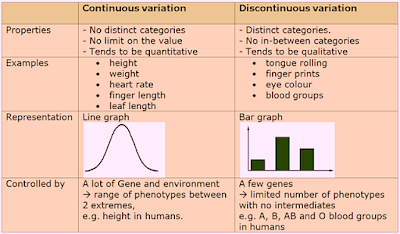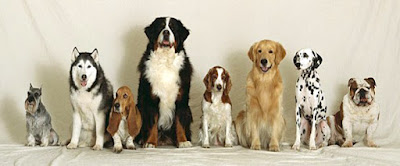SPM Biology 15 Variation (Part 1)
 |
| Variation |
Variation means the differences between the individuals of the same species. There are two types of variations, namely continuous variation and discontinuous variation.
In continuous variation, the differences are slight and they grade into each other. They are usually no limit on the value and tends to be quantitative. They are considerable influences of the environment. For instance, height, body weight, and skin colour. The shape of the continuous variation's graph is normal distribution.
In discontinuous variation, the differences are discreet and clear cut. They do not merge into each other. They are controlled by one, two or very few genes and tends to be qualitative. For examples, type of hair, type of earlobes, tongue rolling, fingerprints, and blood group. The shape of discontinuous variation's graph is discreet distribution.
 |
| Comparison between Continuous and Discontinuous Variation |
What are the factors that cause variation?
1. Environmental Factors
Change the phenotypes of plants resulting in acquired characteristics which cannot be inherited. It also determines the survival of plants. Continuous variation in humans are also the product of environmental influence.
 |
| Environmental factors |
2. Genetic Factors
In prophase I, pairing of homologous chromosome will form chiasma. Chromosomal crossing-over happens in the chiasma and there are exchange of genes between the two chromatids of the homologous chromosome. In metaphase I, chromosomes are aligned randomly and various gametes that contain different pairs of chromosomes are formed. In anaphase II, chromatids are separated and gametes with a variety of combinations of genes are produced.
 |
| Homologous chromosomes |
Gametes from different parents are fertilised randomly and cause genetic variations. Gametes with diverse combinations of homologous chromosomes are fused together to form a zygote which intern produces greater variety of gene combinations.
The traits of an organism are controlled by a single pair of alleles or by several pairs of alleles. The traits that are controlled by several pairs of alleles are influenced by the environment.These alleles interact with one another and with the environment. For instance, the colour of the skin is affected by genetic factors. The colour of the skin of an individual become darker when exposed to sunlight. So, the change of colour of the skin is affected by the interaction between genetic factors and environmental factors on continuous variation.
Variation is important to a species because only the individuals best adapted to their environment ted to survive and transmit their genetic characteristic to the offspring. From time to time, there will be changes in the individual of a particular species, with the better adapted ones increasing in population. This is called the "Survival of the Fittest" or "Natural Selection".
 |
| Variation |





clear explaination I like it!!!
ReplyDeleteThank you for you support ^^
Deletegreat and brief explaination!!!!!
ReplyDeleteThank you for your support!
ReplyDelete